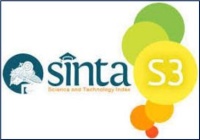Potensi Metabolit Sekunder Tanaman Syzygium sp. Terhadap LOX-1 Sebagai Target Terapi Penyakit Aterosklerosis: Studi In Silico
Abstract
Atherosclerosis is a cardiovascular disease characterized by the accumulation of oxidized lipoproteins in the arterial wall, which is triggered by LOX-1 receptor activation. The members of Syzygium genus contains secondary metabolites with antioxidant and anti-inflammatory activities that have the potential to inhibit LOX-1. This study aims to evaluate the interaction of compounds from Syzygium cumini, Syzygium aromaticum, Syzygium malaccense, and Syzygium jambos against LOX-1 using in silico method. Analysis was conducted through molecular docking, pharmacophore selection based on hydrophobic and hydrogen bond interaction criteria, and validation using Root Mean Square Deviation (RMSD ≤ 3 Å) values. The research results showed that gallic acid has the highest affinity (-4.1 kcal/mol), followed by linalool (-3.8 kcal/mol), kaempferol (-3.4 kcal/mol), oxalic acid (-3.4 kcal/mol), quercetin (-2.2 kcal/mol), and myricetin (-1.4 kcal/mol). The compounds with the highest affinity interacted with key LOX-1 residues, suggesting potential inhibition of the receptor. In conclusion, gallic acid is the most potent LOX-1 inhibitor candidate based on its stable interaction and highest affinity value. Further studies are needed to confirm its biological activity through in vitro and in vivo approaches.
Keywords
Full Text:
PDFReferences
Astutik, P., Yuswantina, R., & Vifta, R. L. (2021). Perbandingan Aktivitas Antifungi Ekstrak Etanol 70% Dan 96% Buah Parijoto (Medinilla speciosa) Terhadap Candida albicans. Journal of Holistics and Health Science, 3(1), 32–41. doi:https://doi.org/10.35473/jhhs.v3i1.66
Candra, G. N. H., & Wijaya, I. M. A. P. (2021). Molecular Docking Kaempferol sebagai Antiinflamasi pada Aterosklerosis secara In Silico. Jurnal Ilmiah Medicamento, 7(1), 13–18. doi:https://doi.org/10.36733/medicamento.v7i1.1497
Chagas, V. T., França, L. M., Malik, S., & Paes, A. M. de A. (2015). Syzygium cumini (L.) skeels: A Prominent Source of Bioactive Molecules Against Cardiometabolic Diseases. Frontiers in Pharmacology, 6. doi:https://doi.org/10.3389/fphar.2015.00259
Erlund, I. (2004). Review of The Flavonoids Quercetin, Hesperetin, and Naringenin. Dietary Sources, Bioactivities, Bioavailability, and Epidemiology. Nutrition Research, 24(10), 851–874. doi:https://doi.org/10.1016/j.nutres.2004.07.005
Evary, Y. M., Djide, N. J. N., & Aulia, I. N. (2024). Discovery of Active Antibacterial Fractions of Different Plant Part Extracts of clove (Syzigium aromaticum) Against Streptococcus mutans. Journal of Experimental Biology and Agricultural Sciences, 12(4), 625–633. https://doi.org/10.18006/2024.
Hasiholan, M. (2020). Penerapan Metode Log (Laplacian Of Gaussian) Dalam Mendeteksi Tepi Citra Pada Penyakit Aterosklerosis. Jurnal Pelita Informatika, 8(4).
Huang, W., Hutabarat, R. P., Chai, Z., Zheng, T., Zhang, W., & Li, D. (2020). Antioxidant Blueberry Anthocyanins Induce Vasodilation via PI3K/Akt Signaling Pathway in High-Glucose-Induced Human Umbilical Vein Endothelial Cells. International Journal of Molecular Sciences, 21(5), 1575. doi:https://doi.org/10.3390/ijms21051575
Johns, A. E., & Radhamany, P. M. (2024). Phytochemical Screening, HPTLC and FT-IR analysis of Methanolic Bark Extract of Syzygium stocksii (Duthie)Gamble- a critically endangered taxon in Myrtaceae. International Journal of Biology and Chemistry, 17(2), 158–166. https://doi.org/10.26577/ijbch2024v17.i2.13
Kattoor, A. J., Goel, A., & Mehta, J. L. (2019). LOX-1: Regulation, Signaling and Its Role in Atherosclerosis. Antioxidants, 8(7), 218. doi:https://doi.org/10.3390/antiox8070218
Kusumorini, A., Suryani, Y., Ayuni, F. Q., & Taupiqurrohman, O. (2024). In-Silico Analysis of Eugenol and Beta-Caryophyllene Compounds in Clove (Syzygium aromaticum L.) on NF-kB Protein As Anti-inflammatory Agent In Atherosclerosis. Elkawnie, 10(1), 88. doi:https://doi.org/10.22373/ekw.v10i1.17387
Lee, W.-J., Ou, H.-C., Hsu, W.-C., Chou, M.-M., Tseng, J.-J., Hsu, S.-L., Tsai, K.-L., & Sheu, W. H.-H. (2010). Ellagic Acid Inhibits Oxidized LDL-mediated LOX-1 Expression, ROS Generation, and Inflammation in Human Endothelial Cells. Journal of Vascular Surgery, 52(5), 1290–1300. doi:https://doi.org/10.1016/j.jvs.2010.04.085
Li, R. L., Wang, L. Y., Liu, S., Duan, H. X., Zhang, Q., Zhang, T., Peng, W., Huang, Y., & Wu, C. (2022). Natural Flavonoids Derived From Fruits Are Potential Agents Against Atherosclerosis. In Frontiers in Nutrition, 9. doi:https://doi.org/10.3389/fnut.2022.862277
Makisake, R. G., Montolalu, R. I., Mewengkang, H. W., Sanger, G., Harikedua, S. D., Makapedua, D. M., Salindeho, N., Zagoto, E. B. S., & Gumolung, I. J. P. A. (2022). Studi In Silico Senyawa Aktif Daun Tagalolo (Ficus Septica Burm F) Sebagai Ligan Uji Pada Enzim L-Histidin Decarboxylase. Media Teknologi Hasil Perikanan, 10(2), 122–126. doi:https://doi.org/10.35800/mthp.10.2.2022.40390
Nur, A. V., Slamet, Waznah, U., Mugiyanto, E., & Pambudi, D. B. (2024). Molecular Docking Metabolit Sekunder Bawang Putih (Allium Sativum) sebagai Antikanker Payudara: Pendekatan In-Silico. In Journal of Integrative Natural Science 2024, 1(1). https://ejournal.unsika.ac.id/index.php/JoINS
Ochieng, M. A., ben Bakrim, W., Bitchagno, G. T. M., Mahmoud, M. F., & Sobeh, M. (2022). Syzygium jambos L. Alston: An Insight Into its Phytochemistry, Traditional Uses, and Pharmacological Properties. Frontiers in Pharmacology, 13. doi:https://doi.org/10.3389/fphar.2022.786712
Rokom. (2023, October 25). Cegah Penyakit Jantung dengan Menerapkan Perilaku CERDIK dan PATUH. Kementerian Kesehatan RI.
Syauqy, A., Rahman, A. O., & Purwakanthi, A. (2020). Pemeriksaan Kadar Kolesterol Darah Pada Masyarakat Umum Saat Car Free Day di Lapangan Gubernur Kota Jambi Sebagai Skrining Awal Hiperkolesterolemia. Medical Dedication (Medic) : Jurnal Pengabdian Kepada Masyarakat FKIK UNJA, 3(1), 18–21. doi:https://doi.org/10.22437/medicaldedication.v3i1.8580
DOI: https://doi.org/10.33394/bioscientist.v13i1.14817
Refbacks
- There are currently no refbacks.

This work is licensed under a Creative Commons Attribution-ShareAlike 4.0 International License.

Bioscientist : Jurnal Ilmiah Biologi is licensed under a Creative Commons Attribution-ShareAlike 4.0 International License
Editorial Address: Pemuda Street No. 59A, Catur Building Floor I, Mataram City, West Nusa Tenggara Province, Indonesia











